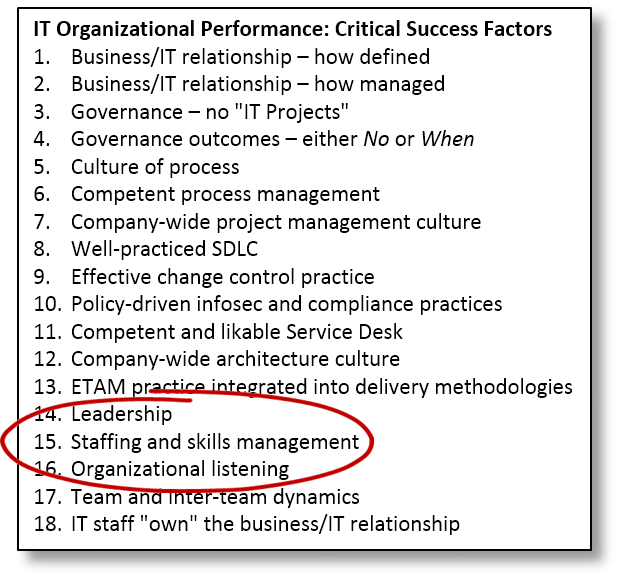People, process, and technology. It’s the standard formulation for what makes an organization tick. With thirteen of our eighteen IT critical success factors down and only five to go, only two have touched on technology … a company-wide architectural culture and an ETAM practice that’s integrated into IT’s delivery methodologies.
None of the remaining five have anything to do with technology, either. How is this possible? It’s an outrage! After all, isn’t technology IT’s job?
The answer lies in the “results loop” (see figure). For an IT organization, information technology is a result … an output. Critical success factors aren’t about outputs. They’re about the inputs and what turns them into outputs.
And when it comes to what’s needed to turn IT’s inputs into its outputs, there isn’t much that matters more than the people who make information technology happen, and the leaders who make sure they’re the right people with the right skills and focus.
This week’s critical success factors … leadership, staffing and skills management, and organizational listening … have a bit of redundancy to them. After all, as explained in Leading IT: (Still) the Toughest Job in the World (he said in a typically shameless plug), two of the eight tasks of leadership are staffing and communication; organizational listening is part of communication.
To which I plead the Emerson Defense (A foolish consistency is the hobgoblin of little minds; the Emerson in question being, of course, Ralph Waldo).
Organizations live and die on leadership excellence across all eight tasks, which is why I include Leadership on the list.
And yet, the eight tasks (setting direction, delegation, staffing, decision-making, motivation, team dynamics, culture, and communication) aren’t perfectly equal in their impact.
Staffing in particular stands out. Nothing is more important … nothing is even as important … as attracting, hiring, retaining, and promoting the best talent you can find. The proof is simple to state and mathematically precise:
Fact #1: Great employees can overcome bad processes, inadequate tools, ambiguous assignments, and just about any other barrier poor management places in their paths.
Fact #2: Poor employees can make a hash of things, even when working within the most elegantly designed processes, using the best tools money can buy, with clearly formulated assignments and precise specifications.
Inescapable conclusion: Having great employees matters more than anything else you as a leader can influence.
Except … just a few short weeks ago I claimed the business/IT relationship is at the top of the list. What’s the deal, Bob?
Good question. Here’s the answer: First, with great relationships you’ll be forgiven even for employing less than the best. Second, broken relationships are one of the few barriers even great employees can’t overcome. And third, see the Emerson Defense, above.
You need great employees. You need to keep their skills sharp and current. You need to remember that recruiting doesn’t stop when you’ve made a great hire. You should treat your great employees as if you’re recruiting them every day they work in your organization, because if you can’t retain great employees, you’ll never find enough new ones to fill all the empty chairs.
Now that you have great employees, there’s something else you have to do that’s also very important (you know, the CSF thing): You need to know What’s Going On Out There. Why you need to know is, I hope, so obvious it doesn’t need a lot of explanation, but just in case: If you don’t know what’s going on out there, you don’t know what needs your attention, what direction to set, what tasks to delegate, or, for that matter, anything else.
And to know What’s Going On Out There calls for organizational listening — the ability to know what the buzz is; what employees are concerned about; what’s working and what isn’t; who your problem managers are if you have any; what business relationships are damaged or completely broken.
Among other things.
To know What’s Going On Out There calls for a lot of different techniques, ranging from formal employee surveys, to walking around, to informal lunches with groups of employees at all levels, to the chain of command (the least-effective technique).
These techniques share two attributes: None is perfect, which is why you need them all.
And, they all take time.
Find it on your calendar. Because if you don’t, no matter how good a manager you are in all other respects, more often than not you’ll find yourself shooting at the wrong target.
And if you do that, even a bulls-eye is a complete miss.

Dear Mr Lewis
I totally agree with your approach regarding Relationship and competence, and regarding the governance, the two above matters should be integrated in how project lifecycle is implemented and organized. regards, Antoine
Bob,
In my experience managing a team of real-time programmers, I found the productivity difference between a GREAT programmer and what everyone else called a GOOD programmer to be a factor of between 50 and 100 times as productive. I was never able to determine what characteristics existed so I could tell this difference during an interview. They both interviewed well. I think the difference between GOOD and MEDIOCRE is maybe 10 to 20 times. As a result, I encouraged my GREAT programmers to set their own rules, and my job was to protect them from the organization processes when I knew it would just get in their way.